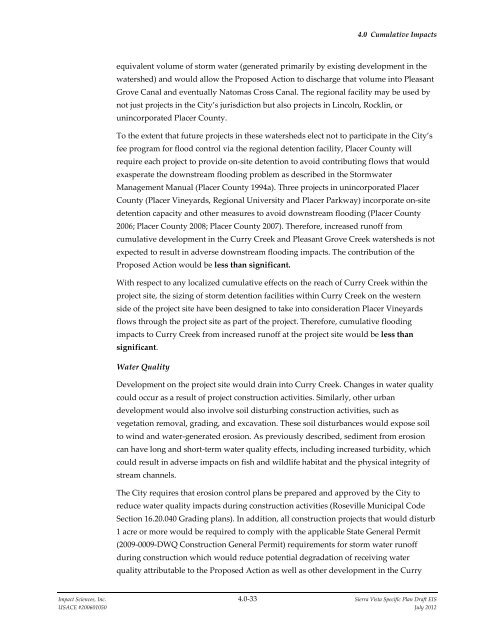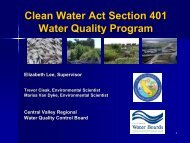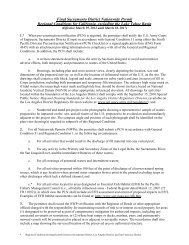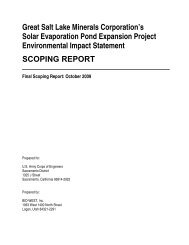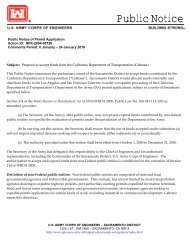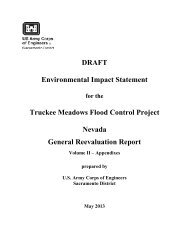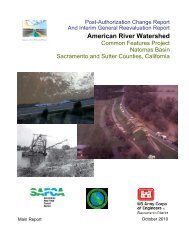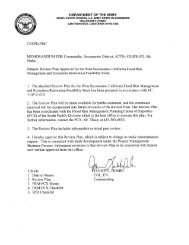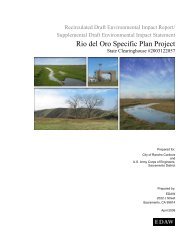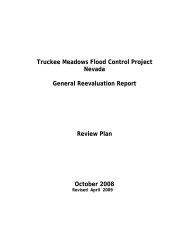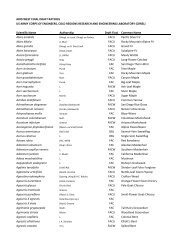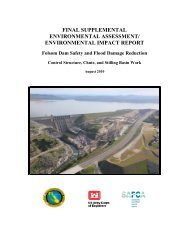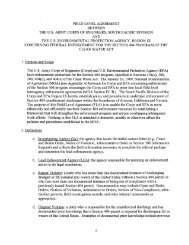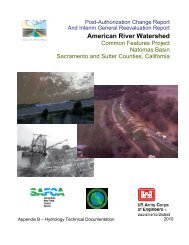4.0 CUMULATIVE IMPACTS - Sacramento District - U.S. Army
4.0 CUMULATIVE IMPACTS - Sacramento District - U.S. Army
4.0 CUMULATIVE IMPACTS - Sacramento District - U.S. Army
Create successful ePaper yourself
Turn your PDF publications into a flip-book with our unique Google optimized e-Paper software.
<strong>4.0</strong> Cumulative Impacts<br />
equivalent volume of storm water (generated primarily by existing development in the<br />
watershed) and would allow the Proposed Action to discharge that volume into Pleasant<br />
Grove Canal and eventually Natomas Cross Canal. The regional facility may be used by<br />
not just projects in the City’s jurisdiction but also projects in Lincoln, Rocklin, or<br />
unincorporated Placer County.<br />
To the extent that future projects in these watersheds elect not to participate in the City’s<br />
fee program for flood control via the regional detention facility, Placer County will<br />
require each project to provide on-site detention to avoid contributing flows that would<br />
exasperate the downstream flooding problem as described in the Stormwater<br />
Management Manual (Placer County 1994a). Three projects in unincorporated Placer<br />
County (Placer Vineyards, Regional University and Placer Parkway) incorporate on-site<br />
detention capacity and other measures to avoid downstream flooding (Placer County<br />
2006; Placer County 2008; Placer County 2007). Therefore, increased runoff from<br />
cumulative development in the Curry Creek and Pleasant Grove Creek watersheds is not<br />
expected to result in adverse downstream flooding impacts. The contribution of the<br />
Proposed Action would be less than significant.<br />
With respect to any localized cumulative effects on the reach of Curry Creek within the<br />
project site, the sizing of storm detention facilities within Curry Creek on the western<br />
side of the project site have been designed to take into consideration Placer Vineyards<br />
flows through the project site as part of the project. Therefore, cumulative flooding<br />
impacts to Curry Creek from increased runoff at the project site would be less than<br />
significant.<br />
Water Quality<br />
Development on the project site would drain into Curry Creek. Changes in water quality<br />
could occur as a result of project construction activities. Similarly, other urban<br />
development would also involve soil disturbing construction activities, such as<br />
vegetation removal, grading, and excavation. These soil disturbances would expose soil<br />
to wind and water-generated erosion. As previously described, sediment from erosion<br />
can have long and short-term water quality effects, including increased turbidity, which<br />
could result in adverse impacts on fish and wildlife habitat and the physical integrity of<br />
stream channels.<br />
The City requires that erosion control plans be prepared and approved by the City to<br />
reduce water quality impacts during construction activities (Roseville Municipal Code<br />
Section 16.20.040 Grading plans). In addition, all construction projects that would disturb<br />
1 acre or more would be required to comply with the applicable State General Permit<br />
(2009-0009-DWQ Construction General Permit) requirements for storm water runoff<br />
during construction which would reduce potential degradation of receiving water<br />
quality attributable to the Proposed Action as well as other development in the Curry<br />
Impact Sciences, Inc. <strong>4.0</strong>-33 Sierra Vista Specific Plan Draft EIS<br />
USACE #200601050 July 2012


